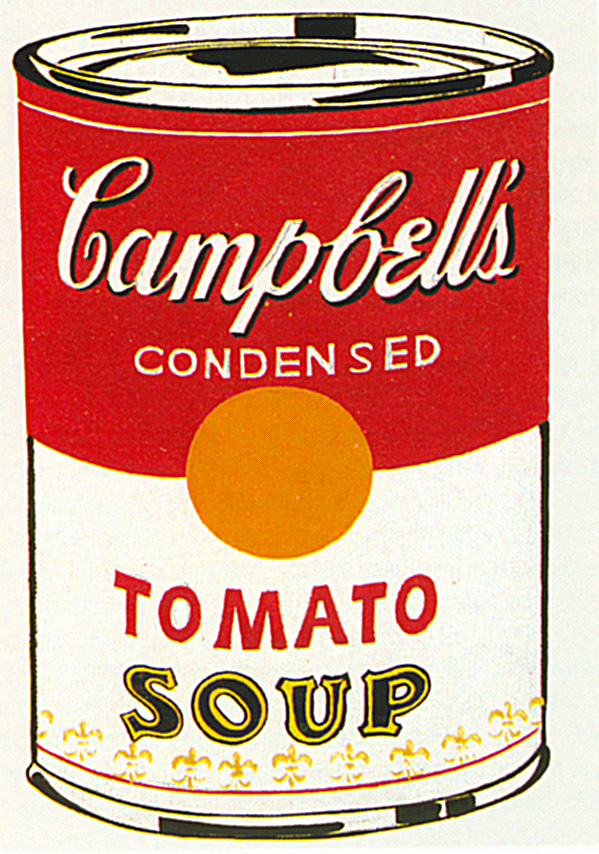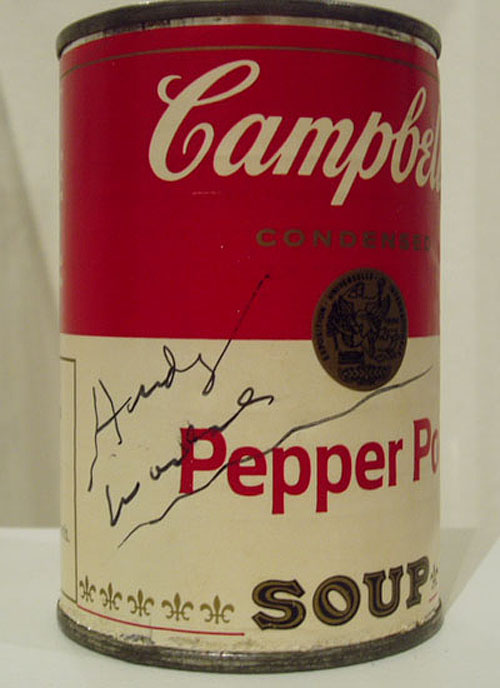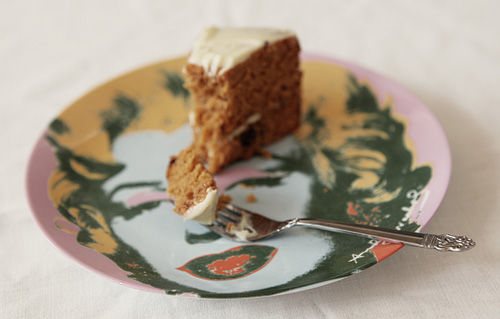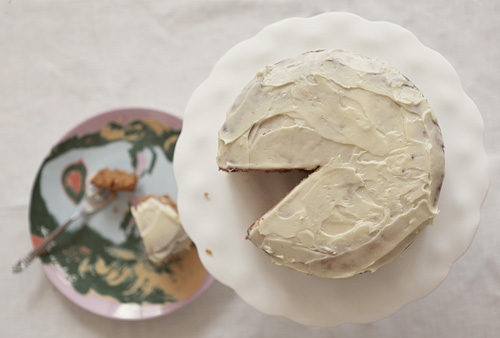Let me first point out that if you decide to make this cake for anyone, call it by its other name, ‘Mystery Cake.’ I first heard of Tomato Soup Cake when I was flipping through a Michigan cookbook while working at a living history museum. This was after my Freshman year of college when cooking consisted of a bowl of cereal or making a peanut butter & jelly sandwich.I was immediately disgusted with the very idea and promptly forgot about the whole thing until I started working on this blog. I prepared this cake the day before two of my college roommates arrived here from Michigan. As soon as they were in the door, I had them seated at the table with a wedge of cake, impatient for them to taste the mystery ingredient. They were both stumped, guessed it was carrot cake (it’s similar in colour and taste), and seemed a bit surprised when I gleefully pulled out a can of tomato soup for the big reveal. I have to say that the entire cake is now gone, so ultimately the can of soup is not too much of a deterrent.

Oil on canvas, 30 x 23 cm, Kunstmuseum St.Gallen
As the leading figure in Pop Art, Andy Warhol introduced the idea of using popular icons (advertisements, celebrities, and brands) as the art subject. He had a tendency to take things literally and when a friend suggested he paint the things he loved, he did just that (1). His first major exhibition consisted of his Campbell’s Soup Can Series that he silkscreened onto canvas with lettering then hand painted. After the opening of the show a bit of a scandal erupted because his art only attempted to replicate a manufactured object but by expanding the preconceived notions of subject material, his depiction of the mundane helped to elevate him in art circles all over the country (2). His silkscreen canvases were made in a very mechanical and methodical way and the art studio where he worked was called the Factory. Warhol mimicked the repetitive way the manufactured objects in his art were initially created by employing a method that allowed him to create many identical multiples of the paintings.

Mixed media / found object, 10 x 6.7 x 6.7 cm, University of Michigan Museum of Art
While I was an art history student at the University of Michigan I visited the Pop! exhibition in 2005. It was there that I found and photographed the above work of art. Warhol moved from reproducing the iconic branding on canvas to creating sculptures that mimicked the packing crates the products arrived in. A couple years later, Warhol finally began signing the cans of soup themselves à la Marcel Duchamp and his readymade sculpture, the urinal he called Fountain. It is Warhol’s signature alone that elevates this banal can of soup into a credible work of art while paying homage to the series that made him famous. No other can of soup has had such an illustrious history so in the end, basing a cake around it does not seem so silly.
It is not only the soup that has a long history, the cake recipe has had its share of fame in it’s 90 years of existence. First published in a recipe booklet by Campbell’s, the cake was featured in the 1942 book, How to Cook a Wolf, by M.F.K. Fisher. In her book she writes “This is a pleasant cake, which keeps well and puzzles people while you are cooking other things, which is always sensible and makes you feel rather noble, in itself a small but valuable pleasure.” The recipe was useful in the 30’s during the Depression and at that time was made with no eggs and almost no butter. In the 1960’s the recipe was revitalized and become more of an assembled concoction of water, a spice mix, and a can of soup (3). My recipe is in line with those found in the 1930’s that created the cake from scratch and although you may decide to call it ‘Mystery Cake’ it may be more apt to call it by it’s third and final name ‘Conversation Cake.’

Tomato Soup Cake
The cake will keep 3 to 4 days in an airtight container. The flavors compliment autumnal recipes and is best served with strong coffee.
Yield: 8 servings
2 cups sifted cake flour
2 teaspoons baking powder
1/4 teaspoon soda
1 teaspoon cinnamon
1 teaspoon nutmeg, cloves, ginger, mixed
1/2 cup butter
1 1/2 cups sugar
2 large eggs
1 can tomato soup
1 cup chopped hazelnuts
Preheat the oven to 350°F/180°C. Sift together flour, baking powder, baking soda, cinnamon, nutmeg, cloves, and ginger. Set aside.
Cream butter and sugar together until light and fluffy, 5 minutes on medium-high setting. Add eggs, one at a time, beating after each for 30 seconds. Add dry ingredients to creamed mixture alternately with soup, beginning and ending with flour mixture. Beat well after each addition for 1 minute. Beat 1 minute longer, then fold in nuts with a spatula.
Pour into two 8-inch round layer pans which have been greased and lined on the bottom with parchment paper. Bake for 30 minutes. Cool 10 minutes in pans, then remove to wire rack to cool thoroughly, 20 to 30 minutes. Frost with cream cheese frosting.

Cream Cheese Frosting
Adapted from Jamie’s America
125 grams cream cheese, softened
75 grams butter, softened (room temperature)
1 cup icing sugar
1 teaspoon vanilla extract
juice & zest from 1/2 lemon
Cream together cream cheese and butter by first mashing together with a fork and then mixing until fluffy with a spatula. Slowly add the icing sugar, vanilla, and lemon and continue stirring until well combined and smooth.

24 comments
dessert girl says:
May 12, 2009
This is awesome! I have to try it! I love the last pic. It looks like a little Pacman. :-)
Lorraine @ Not Quite Nigella says:
May 12, 2009
Megan that is SO creative! I’ve never seen a cake recipe like it! I’m totally intrigued!
tres jolie says:
May 12, 2009
Thanks you two! I am just glad your responses are not, ‘Ewwww why would you put that in a cake?!’br /br /It is funny Pacman was mentioned because if you click on the picture and visit the flickr page you will see that I wrote that I liked the photo because it looked like Pacman about to eat the wedge of cake.
Julie says:
May 12, 2009
Megan, I am delighted that you included an Andy Warhol tomato soup can as one of your still lifes -tomato soup is one of my favorite comfort foods. And the cake sounds like great fun. Great job on coming up with yet another intriguing recipe.
MeetaK says:
May 13, 2009
megan, i love this innovative idea! it’s perfect and i am curious as to the flavor. glad you are bringing this along to the mingle!
Rebekka says:
May 13, 2009
I love the concept of this blog, sooo interesting! I studied art history in college too, before going to culinary school. I can’t wait to look around some more!
petoskeygirl says:
May 14, 2009
The cake looks so good. I can’t wait to try it. I have a Andy Warhol original hanging in my garage. Keep up the good work.
Arwen from Hoglet K says:
May 14, 2009
That’s really cool. I’ve never seen a cake made on soup before, which makes it extra interesting. Maybe you can call it Warhol cake, to give people a clue.
zested says:
May 14, 2009
What a fun idea – I’m so intruiged by the idea of tomato soup in a cake. It’s about my level of baking expertise – I’m totally going to give it a try.
art and lemons says:
May 15, 2009
A pleasant, noble, and mysterious cake indeed! I can’t wait to see what comes next…
Siri says:
May 15, 2009
This is totally unrelated, but made me think of you:br /br /http://kitchenscraps.ca/2009/05/15/vincent-van-goghs-sunny-sunflower-cake/
tres jolie says:
May 15, 2009
Thank you for your kind words everyone!! br /br /Siri that is the best link ever!!
Karen says:
May 17, 2009
That cake was seriously delicious! I think I ate it for breakfast every day of my visit. I’m so glad I finally got to try one of your creations.
pigpigscorner says:
May 18, 2009
Such a creative recipe!
The Food Hunter says:
May 20, 2009
interesting…I’d give it a try.
Hirst’s Cineole Cupcakes »Feasting on Art says:
Mar 2, 2010
[…] Sometimes I can’t help myself, I just have to indulge in a bit of kitsch. Cupcakes and pharmaceuticals are not a likely combination but I stayed true to the spot painting production and created a slightly different shade for each little cake and arranged them in a random order. The cake is the red velvet variety sans the red colouring. It is moist and rich and wonderfully sour paired with the lemon cream cheese icing. […]
Bimbi’s Sour Cherry Turnovers with Goat Cheese »Feasting on Art says:
May 9, 2010
[…] Year Ago: Warhol’s Tomato Soup Cake Tags: Bake, Bimbi, cherry, Dessert, Fruit, goat cheese, pie Category: Bake, Dessert, Fruit This […]
Olivia Smith says:
Jun 11, 2010
I really love to eat lots of different kinds of soup specially vegetable based soups.:”,
Archie Hill says:
Oct 1, 2010
i love to eat cakes and bake them too that is why i am always on the lookout for cake recipes.
Gale Juhasz says:
Dec 13, 2010
Wow! That is a single of the most beneficial blogs I’ve actually occur throughout on this subject. Basically Amazing
@mfizell says:
Aug 6, 2012
In honor of Andy Warhol’s (@thewarholmuseum) birthday, here is a recipe for tomato soup cake inspired by his famous art http://t.co/WR3KaQP4
@NJB2000 says:
Aug 6, 2012
Andy Warhol, Campbell’s Soup Cake http://t.co/gGnRTjUh
Valarie says:
Oct 11, 2012
My family has been making this for years – never knew where the recipe came from – just one handed down from generation to generation. We have always but raisens in it – I prefer chocolate chips instead of raisens.
@nkulikowski says:
Apr 12, 2013
While searching for Warhol dessert recipes today, I discovered Tomato Soup Cake and @mfizell. Why’d it take so long?! http://t.co/tIUq6qoAzf